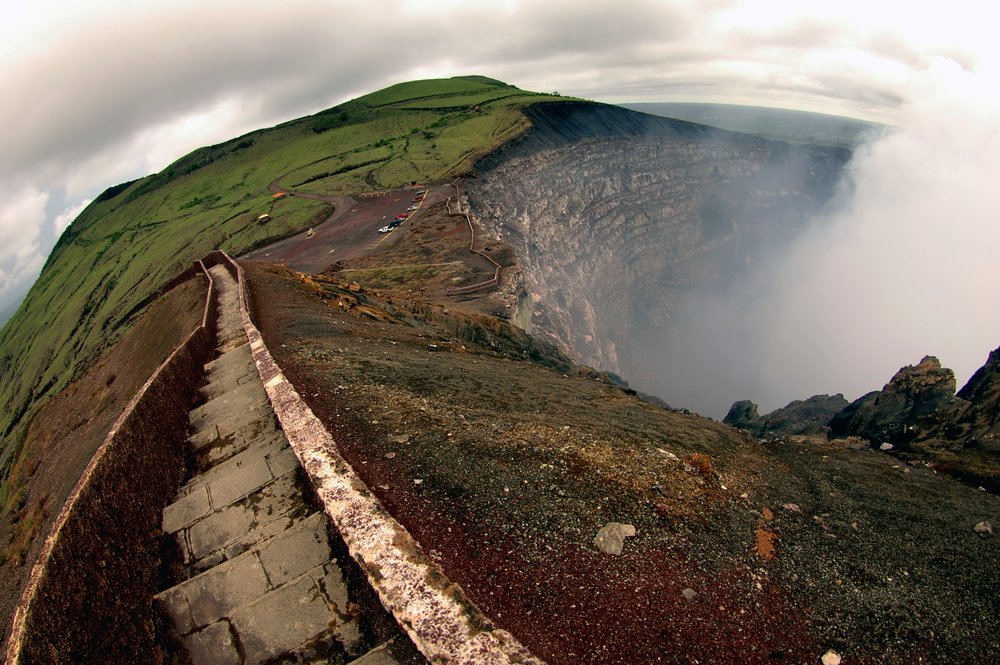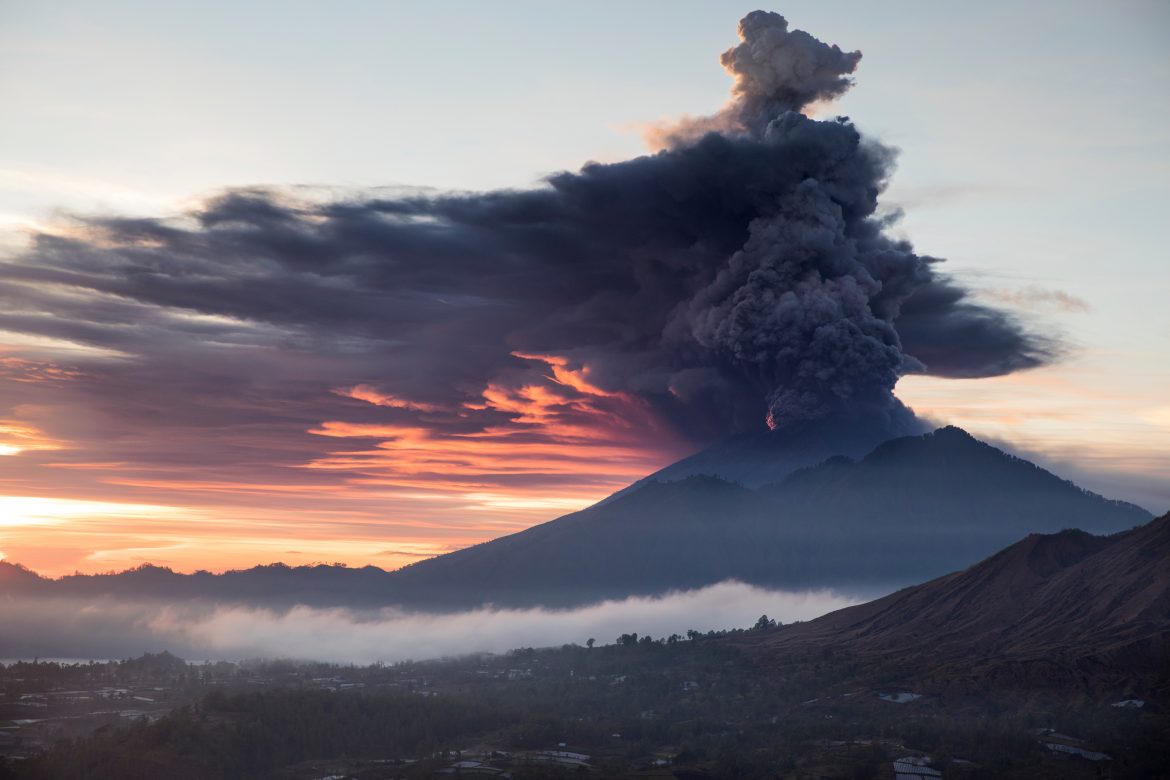Volcanoes are one of those reminders that man is never greater than nature. No matter how tall our buildings get or how strong we think our walls are, we don’t stand a chance against Mother Earth. And perhaps that’s why volcanoes are so fascinating to us. They’re dangerous, unpredictable, and treacherous…and yet, that danger holds a certain beauty. A power. It makes us stop and realize that our planet is alive, is moving, and is always changing.
Volcanoes can destroy cities, yet create islands. To visit one during your travels is a way to experience both Earth’s power of destruction and rebirth. Here are the five coolest places to see volcanoes around the world.
BALI, INDONESIA

Paru Ulun Danu Bratar (Photo: Guitar photographer)
Bali has three main volcanoes – Batur, Bratan, and Agung.
Bratan is still active, but hasn’t had an eruption for quite some time. Instead, the island generates geothermal power from the volcanic heat that still flows underneath the surface. Also, almost every traveler will know Bratan because it’s featured in almost every Bali photograph ever taken. The famous Pura Ulun Danu Bratan temple is built on the shores of a lake that formed inside the volcano’s crater. Nearby the temple is the Bali Botanic Garden, which utilizes the area’s rich volcanic soil to grow a plethora of gorgeous orchids, ferns, and even rare carnivorous pitcher plants.
Batur last erupted in 2000, but is still teeming with geothermal heat which warms the groundwater, making the mountain an oasis of hot springs. Most notably are Toya Devasya Hot Springs and Batur Natural Hot Springs. The volcano itself has been designated a UNESCO Global Geopark to preserve its natural beauty and geothermal properties. Visitors can hike the volcano, and upon reaching the top, will be rewarded with stunning views of the South Pacific.

Mount Agung (Photo: Nina Janesikova)
Agung is Bali’s most famous volcano. It last erupted between 2017 to 2019, displacing residents, stranding thousands of tourists, and canceling hundreds of flights. The eruption was documented heavily in the media as various celebrities were in Bali at the time. Because of how unstable the volcano is, it’s currently closed to visitors. However, it’s also your best chance of witnessing an active eruption on the island.
KYUSHU, JAPAN

Mount Aso (Photo: gnoparus)
On the island of Kyushu in Japan sits the Mount Aso volcano. Its caldera (the bowl shape that forms after an eruption) is almost 16 miles long and 11 miles wide. It’s the largest active volcano in Japan and one of the largest in the world.

Mount Aso (Photo: ymgerman)
What makes Aso so special is that its one of the few active volcanos in the world that is visually active. The lake at the center of the volcano’s crater bellows steam and volcanic gasses into the sky, making it a special sight for visitors. It’s most recent major eruption was about 90,000 years ago, so visiting the volcano is deemed safe. Travelers can view into the steaming crater or relax in one of the region’s numerous hot springs and “ryokans” (traditional Japanese inns) which have their own built-in springs. The volcano is also a great spot for hiking and horseback riding.
MASAYA, NICARAGUA

Masaya Volcano (Photo: Erik Klietsch)
Located in Masaya, Nicaragua, the Masaya Volcano offers visitors one of the rarest sights in the world – A look into a magma-filled volcano.
The volcano is protected within a National Park and visitors can see the volcano both during day and night. By day, you can see the steam clouds rising up from the volcano’s lava lake and get panoramic views of the surrounding area. By night, you can see the striking color of the volcano’s red glow as the magma slowly bubbles beneath you.

Masaya Volcano (Photo: holdeneye)
Masaya is also an important scientific tool. It’s a rarity to get so close to an active, lava-filled volcano. Scientists use Masaya to study things like volcanic gas emissions, heat ranges, and seismic activity in order to better understand volcanoes and geothermic potential.
WASHINGTON STATE, USA

Mount Rainier (Photo: Earl’s Photos)
While Hawaii is known for being an archipelago created by volcanoes, much of the activity has slowed since the massive 2018 eruption on Hawaii’s Big Island. Visitors can no longer view the puffing geysers or rivers of lava that the islands were famous for.
With Hawaii going dormant, visitors should set their sights on another state with a volcanic reputation…Washington. The Cascade Range actually has five active volcanoes – Mount Baker, Glacier Peak, Mount Rainier, Mount Adams, and Mount St. Helens.
Mount Rainier is special because of how close it is to Seattle. In fact, you can see the 14,400 ft. mountain towering above the skyline of downtown. Rainier can be hiked, or, for some amazing photos, take a trip to the top of Seattle’s Space Needle and grab some incredible views from the tower’s outdoor observation deck.

Mount St. Helens (Photo: Roman Khomlyak)
But the most notorious of Washington’s volcanoes is Mount St. Helens. Flashback to May of 1980. For the past two months, Mount St. Helens had been experiencing small earthquakes and minor eruptions. Then, on May 18th, a level 5 earthquake caused a rockslide, cracking the volcano, allowing a massive release of pressure. The rapid pressure change made water in the volcano to boil, releasing a massive amount of pressurized steam, causing the mountain to, quite literally, explode.
These days, the volcano is known for its odd shape, looking like someone came and scooped off the top of the mountain. But before the 1980 explosion, Mount St. Helens looked like your typical snow-covered mountain peak. Visitors can head to Mt. St. Helens State Park to learn about volcanoes, the 1980 eruption, and how it changed the region’s ecosystem forever. Or, if you’re feeling brave, you can embark on a hike to the volcano’s summit.
SOUTHERN ITALY

Mount Etna (Photo: Arts Illustrated Studios)
Many probably don’t associate Italy with volcanoes, but two of the most famous volcanoes in the world reside within the nation’s borders.
First, Mount Etna, located in Sicily, is one of the tallest active volcanoes on the planet. It’s listed as one of the world’s DECADE volcanoes (which is a list of the world’s 16 most powerful volcanoes) and has been almost constantly erupting since 1949. The mountain makes for some excellent hiking and cross-country skiing and can be seen from every corner of the Sicilian city of Catania. Better yet, the rich volcanic soil is what makes the region such a prime area for vineyards and olive orchards.

Mount Vesuvius behind the ruins of Pompeii (Photo: Boerescu)
There’s also the volcano known around the world – Mount Vesuvius. In 79 A.D., the volcano erupted. Ash billowed into the sky and began raining down on nearby cities, rivers of lava raced down the mountainside, and a deadly superheated gas cloud shot out in all directions. People in the cities below suffocated to death and were buried alive under the falling ash.
What makes the region so fascinating is that those who lost their lives in the nearby cities of Pompeii and Herculaneum were mummified by the ash and rubble, preserving their bodies and possessions. Both Mount Vesuvius and Pompeii are now a National Park and a UNESCO World Heritage Site. Pompeii is open to visitors to learn about one of the most famous events in all of history, and to explore the ruins. Mt. Vesuvius is open to visitors for hiking.


